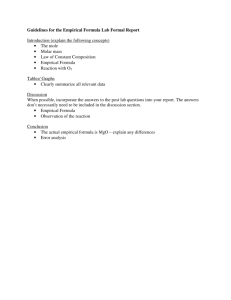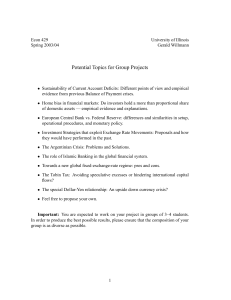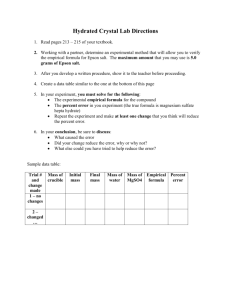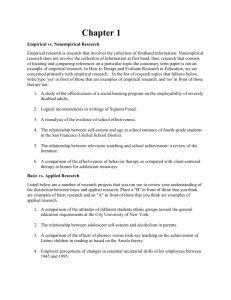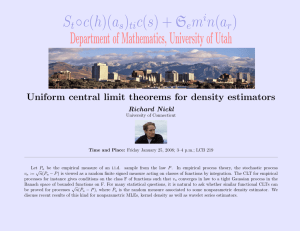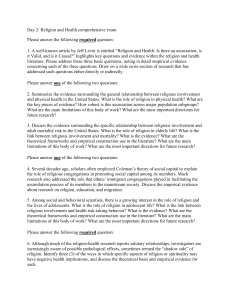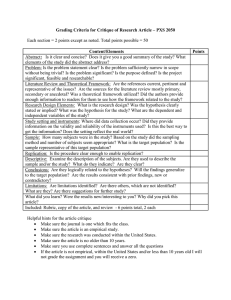Document 13326275
advertisement
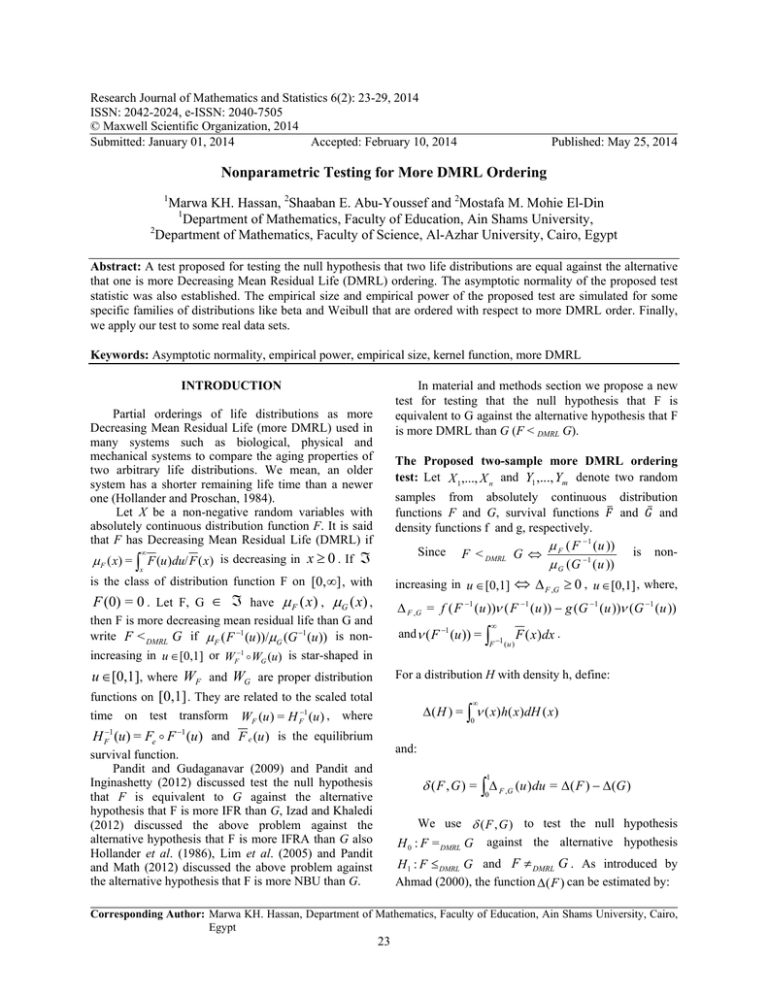
Research Journal of Mathematics and Statistics 6(2): 23-29, 2014
ISSN: 2042-2024, e-ISSN: 2040-7505
© Maxwell Scientific Organization, 2014
Submitted: January 01, 2014
Accepted: February 10, 2014
Published: May 25, 2014
Nonparametric Testing for More DMRL Ordering
1
Marwa KH. Hassan, 2Shaaban E. Abu-Youssef and 2Mostafa M. Mohie El-Din
1
Department of Mathematics, Faculty of Education, Ain Shams University,
2
Department of Mathematics, Faculty of Science, Al-Azhar University, Cairo, Egypt
Abstract: A test proposed for testing the null hypothesis that two life distributions are equal against the alternative
that one is more Decreasing Mean Residual Life (DMRL) ordering. The asymptotic normality of the proposed test
statistic was also established. The empirical size and empirical power of the proposed test are simulated for some
specific families of distributions like beta and Weibull that are ordered with respect to more DMRL order. Finally,
we apply our test to some real data sets.
Keywords: Asymptotic normality, empirical power, empirical size, kernel function, more DMRL
In material and methods section we propose a new
test for testing that the null hypothesis that F is
equivalent to G against the alternative hypothesis that F
is more DMRL than G (F < DMRL G).
INTRODUCTION
Partial orderings of life distributions as more
Decreasing Mean Residual Life (more DMRL) used in
many systems such as biological, physical and
mechanical systems to compare the aging properties of
two arbitrary life distributions. We mean, an older
system has a shorter remaining life time than a newer
one (Hollander and Proschan, 1984).
Let X be a non-negative random variables with
absolutely continuous distribution function F. It is said
that F has Decreasing Mean Residual Life (DMRL) if
The Proposed two-sample more DMRL ordering
test: Let X 1 ,..., X n and Y1 ,..., Ym denote two random
samples from absolutely continuous distribution
functions F and G, survival functions
and ̅ and
density functions f and g, respectively.
1
Since F < DMRL G F ( F ( u )) is non G ( G 1 ( u ))
F ( x) = F (u )du/ F ( x) is decreasing in x 0 . If
x
increasing in u [0,1] F ,G 0 , u [0,1] , where,
is the class of distribution function F on [0,] , with
F (0) = 0 . Let F, G have F (x) , G (x) ,
F ,G = f ( F 1 (u )) ( F 1 (u )) g (G 1 (u )) (G 1 (u ))
then F is more decreasing mean residual life than G and
write F < DMRL G if F ( F 1 (u ))/G (G 1 (u )) is nonincreasing in u [0,1] or WF1 WG (u) is star-shaped in
and ( F 1 (u )) =
u [0,1], where WF and WG are proper distribution
functions on [0,1] . They are related to the scaled total
time on test transform
F 1 ( u )
F ( x)dx .
For a distribution H with density h, define:
( H ) = ( x ) h( x ) dH ( x )
WF (u ) = H F1 (u ) , where
0
H F1 (u) = Fe F 1 (u) and F e (u ) is the equilibrium
and:
survival function.
Pandit and Gudaganavar (2009) and Pandit and
Inginashetty (2012) discussed test the null hypothesis
that F is equivalent to G against the alternative
hypothesis that F is more IFR than G, Izad and Khaledi
(2012) discussed the above problem against the
alternative hypothesis that F is more IFRA than G also
Hollander et al. (1986), Lim et al. (2005) and Pandit
and Math (2012) discussed the above problem against
the alternative hypothesis that F is more NBU than G.
1
( F , G ) = F ,G (u ) du = ( F ) (G )
0
We use ( F , G ) to test the null hypothesis
H 0 : F = DMRL G against the alternative hypothesis
H1 : F DMRL G and F DMRL G . As introduced by
Ahmad (2000), the function (F ) can be estimated by:
Corresponding Author: Marwa KH. Hassan, Department of Mathematics, Faculty of Education, Ain Shams University, Cairo,
Egypt
23
Res. J. Math. Stat., 6(2): 23-29, 2014
1
fˆn ( x)
na n
n
i 1
k(
x Xi
)
an
where,
x Yi
)
bm gˆ m ( x)
1
mbn
ˆn ( x) =
1 n
( X j x) I ( X j > x)
n j =0
m
i 1
k(
(1)
and:
And Fn is empirical distribution of F. The function k in (1) is a known symmetric and bounded probability
density function with mean 0 and finite variance k2 and {an } is a equence of positive real numbers such that an 0
as n . The density function K is known as kernel function and sequence {an } is known as bandwidth
(Silverman, 1986).
Also, let bm be a sequence of positive real numbers such that bm 0 as m , then similar to ˆ ( F ) , ˆ (G) can
be estimated by:
ˆ (G ) = ˆm ( x ) gˆ m ( x ) dGm ( x )
0
where,
gˆ m ( x ) =
1
bm
m
k (
i =1
x Yi
),
bm
(2)
and:
ˆm ( x) =
1 m
(Y j x) I (Y j > x)
m j =0
And Gm is empirical distribution of G. Now, the test statistic:
ˆ ( F , G ) = ˆ ( F ) ˆ (G ) =
1 n
1 m
ˆ ( X i ) fˆn ( X i ) i =1ˆm (Yi ) gˆ m (Yi )
i =1 n
n
m
=
X X
1
n
n
n
( X j X i ) I ( X j > X i )k ( i a l )
n3an i =1 j =1 l =1
n
1
Y Y
m
m
m
(Y Yi )I (Yj > Yi )k ( i l )
i =1j =1l =1 j
m bm
bm
3
Can be used to test H 0 : F = DMRL G against H1 : F < DMRL G and F DMRL G . We need the following theorem
due to Ahmed (2000) to obtain the asymptotic distribution of test statistic.
Theorem 1: If nan and nan4 0 , If f has bounded first and second derivative and if limnV (ˆ F ) > 0 , the
n (ˆ F ) is asymptotically with mean 0 and variance F2 given by:
24 Res. J. Math. Stat., 6(2): 23-29, 2014
X
X
2f = V [ X 1 1 f ( x)dF ( x) 1xf ( x)dF ( x)] 2[ f ( X 1 ) xdF ( x) X 1 f ( X 1 ) F ( X 1 )]
0
Theorem 2: Let a n and
0
bm
(3)
X1
be two sequences of positive real numbers such that:
an 0 , nan and nan4 0 as n .
bm 0 , mbm and mbm4 0 as m .
For all m, n N and some constant c (0, 1 ] we have that:
2
n
0 < c 1 c < 1, where N = n m
N
If f and g have bounded first and second derivatives such that for all combination of p = 1,2, q = 1,2,3 and r = 2.
0
x p ( f ( x)) q f ( r ) ( x)dx <
x
p
0
( g ( x)) q g ( r ) ( x)dx <
Then as min ( n , m ) ,
n (ˆ ( F , G ) ( F , G )) is asymptotically normal with mean 0 and variance
2f ,g
given by:
2f , g =
N 2 N 2
f g
n
m
where, 2f is given in 3 and g2 is defined similarly.
Proof: The proof of the required result is based on Theorem (1) and the fact that generally convergence in the
distribution is closed under the convolution.
2
We use the following lemma to show that in Theorem (3) that ˆ f , g given by:
ˆ 2f , g =
=
N 2
N
[ ˆn ( x) fˆn2 ( x)dFn ( x) ˆ 2 ( F )] [ ˆm2 ( x) gˆ m2 ( x)dGm ( x) ˆ 2 (G )]
n 0
m 0
N
X Xl
X Xs
n
n
n
n
n
( X j X i )( X r X i ) K ( i
)K ( i
)
2 i =1 j =1l =1r =1s =1
n an
an
an
6
I ( X j > X i )I ( X r > X i )
(Yr Yi ) K (
Nˆ 2 ( F )
N
6 2
n
m bm
m
m
m
m
m
i =1
j =1
l =1
r =1
s =1
(Y j Yi )
Yi Yl
Y Y
Nˆ 2 (G )
) K ( i s ) I (Y j > Yi ) I (Yr > Yi )
bm
bm
m
Is the consistent estimator of 2f ,g .
Lemma 1: Let
a n be a sequence of positive real numbers such that nan2 as n and let f be uniformly
continuous. Then:
25 Res. J. Math. Stat., 6(2): 23-29, 2014
ˆ ( F ) p ( F ) , if p ( x ) f q ( x ) dF ( x ) is finite for ( p, q ) (1,0), (1,1) and
ˆ
2
n
( x ) fˆn2 ( x) dFn ( x ) p 2 ( x ) f 2 ( x )dF ( x ) is finite for ( p, q) (2,0), (2,1), (2,2) .
Proof: (i) Using triangular inequality, we have that:
| ˆn ( x) fˆn ( x)dFn ( x) ( x) f ( x)dF ( x) |
| ˆn ( x) fˆn ( x)dFn ( x) ( x) f ( x)dFn ( x) |
(4)
| ( x) f ( x)dFn ( x) ( x) f ( x)dF ( x) |
= An Bn
Since ( F ) < , the weak law of large numbers implies that Bn 0 in probability as:
n
Next, it is clear that:
An sup | fˆn ( x ) f ( x ) | [ ˆn ( x ) dFn ( x ) ( x ) dF ( x )]
Using the assumptions that f is uniformly continuous and nan2 as n , it follows from Theorem 3A of
Parzen (1962) that sup | fˆn ( x ) f ( x ) | converges to 0 in probability. On the other hand, by the weak law of large
numbers we have that:
ˆ ( x)dF ( x) p ( x)dF ( x)
n
n
Hence, An 0 in probability as n and proof of part (i) is completed.
In this case we also have that:
| ˆn2 ( x ) fˆn2 ( x ) dFn ( x ) 2 ( x ) f 2 ( x ) dF ( x ) || {ˆn2 ( x ) fˆn2 ( x ) 2 ( x ) f 2 ( x )}dFn ( x ) |
| 2 ( x ) f 2 ( x){dFn ( x ) dF ( x )} |= An Bn
By the weak law of large numbers, Bn
2
( x) f ( x)dF ( x) < . It is easy to see that:
converges to 0 in probability as n since by assumption
2
An sup | fˆn ( x) f ( x) | [ ˆn2 ( x) fˆn ( x)dFn ( x) 2 ( x) f ( x)dFn ( x)]
(5)
Now, by assumption that nan2 as n , the first term on the right hand side of (5) converges in
probability to 0 by Theorem 3A in Parzen (1962). The second term in the bract, on the right hand side of 5, by the
weak law of large numbers, converges to 2 ( x) f ( x)dF ( x) as n , since 2 ( x) f ( x ) dF ( x ) < . On the other
hand, since 2 ( x)dF ( x) < , replacing (x ) with 2 ( x) in (4) we obtain that:
ˆ
2
n
( x) fˆn ( x)dFn ( x) 2 ( x) f ( x)dF ( x)
when,
nan2 as n
26 Res. J. Math. Stat., 6(2): 23-29, 2014
Combining these observations, the required result of
part (ii) follows.
o
Theorem 3: Let {an} and {bm} be two sequences, of
positive real numbers such that:
Because are bounded and symmetric distributions
about 0 and have finite variance.
2
nan2 as n
nbm2 as m
and:
Let
p
(x) f
q
be
( x ) dF ( x )
and
( p , q ) {(1,0), (1,1), (2,0), (2,1), (2,2)}
uniformly
continuous.
ˆ
Then
2
f ,g
finite
for
f
be
p
2
f ,g
as
Proof: Since:
The algorithm of calculate of the empirical power:
ˆ = ˆ ( x) fˆ ( x )dFn ˆ ( F )
2
n
2
n
2
ˆ g2 = ˆm2 ( x) gˆ m2 ( x)dGm ˆ 2 (G )
o
o
It follows from 1 that ˆ 2f p 2f and ˆ g2 p g2 as
min ( n, m ) , which in turn imply that
ˆ 2f , g p 2f , g as min ( n, m ) .
o
asymptotically standard normal and therefore we reject
H0 in favor of H1 at level α if N ˆ ( F , G )/ˆ f , g > z ,
where, zα is (1 ) -quantile of standard normal
distribution.
Empirical size and empirical power: We will use
Weibull and beta families of distributions for
simulation study to justify the power of our proposed
test and the accuracy of the standard normal as a limit
distribution of the test statistic under H0 (empirical
size). The choice of Weibull family and beta family
because are ordered according to more IFRA ordering
(Chandra and Singpurwalla, 1981; Van Zwet, 1970;
Izadi and Khaledi, 2012) then it is also ordered
according to more DMRL.
The samples size are given by n = m = 10, 30, 40,
50, 100.
The significance level α is given by α = 0.05, 0.
For each significance level, preform 104
simulation run and compute the empirical size and
obtain the number of rejections of H0. Dividing the
number of rejections by 104, the empirical power
are computed.
In Table 3 and 4, we obtain the empirical powers of
the proposed test according to the above algorithm. We
observe that the power of test is close to 1 when
n = m = 20 for beta distribution. Also, when
n = m = 30 the empirical power for Weibull
distribution is large even for the cases when
n = m = 20 , n = m = 40 , n = m = 50 and
n = m = 100 .
The algorithm of calculate the empirical size:
o
We take the following distributions as a kernel
functions
Standard normal distribution
1
1
f ( x) =
Exp [ x 2 ], < x <
2
2
Uniform distribution f ( x) = 1 ,1 < x < 1
2
Because are bounded and symmetric distributions
about 0 and have finite variance.
With the results of Theorem 2 and 3, it follows
from Slutsky’s theorem that
N ˆ ( F , G )/ˆ f , g is
The samples size are given by n = m = 100, 200
The significance level α is given by α = 0.05, 0.1
For each significance level, preform 104 simulation
run and compute the empirical size
In Table 1 and 2, we compute the empirical size of
the proposed test according to the above algorithm. The
entries in these table show that the empirical size is
increasing in m and n. Also the proposed test is
powerful because the empirical size is similar to
significant level α.
min ( n , m ) .
2
f
(Uniform distribution: f ( x) = 1 ,1 < x < 1
We take the following distributions as a kernel
functions
Standard normal distribution:
Numerical example: Table 5 shows two sets of life test
data corresponding to snubber designs of a toaster
component taken from Table (8.3.1) of Nelson (1982).
1
1
Exp [ x 2 ], < x <
2
2
Ahmad (2000) showed that under the null
hypothesis H 0 : F = DMRL E (F is an exponential
f ( x) =
27 Res. J. Math. Stat., 6(2): 23-29, 2014
Table 1: The empirical size of the proposed test when the kernel function is standard normal
Distribution
m = n = 100
---------------------------------------------------------------------------------------------F
G
α = 0.05
α = 0.1
B (0.5, 1)
B (0.5, 1)
0.038
0.023
B (1.5, 1)
B (1.5, 1)
0.036
0.038
W (5, 1)
W (5, 1)
0.027
0.021
W(6,1)
W(6,1)
0.021
0.027
n = m = 200
----------------------------------------------α = 0.05
α = 0.1
0.177
0.282
0.131
0.227
0.091
0.179
0.144
0.233
Table 2: The empirical size of the proposed test when the kernel function is uniform distribution (-1, 1)
Distribution
m = n = 100
-------------------------------------------------------------------------------------------------F
G
α = 0.05
α = 0.1
B (0.5, 1)
B (0.5, 1)
0.058
0.064
B (1.5, 1)
B (1.5, 1)
0.024
0.074
W (5, 1)
W (5, 1)
0.031
0.048
W (6, 1)
W (6, 1)
0.029
0.048
n = m = 200
----------------------------------------------α = 0.05
α = 0.1
0.120
0.130
0.109
0.132
0.122
0.135
0.094
0.069
Table 3: The empirical power of the proposed test when the kernel function is standard normal
Distribution
Sample sizes
-------------------------------------------------------------------------------------------------------------------------------------------------------------------F
G
m = n = 20
m = n = 30
n = m = 40
n = m = 50
n = m = 100
B (0.5,1)
B (0.5, 1)
0.998
0.500
0.914
0.500
0.500
B (1.5, 1)
B (1.5, 1)
0.760
0.741
0.589
0.527
0.564
W (5, 1)
W (5, 1)
0.500
0.500
0.500
0.500
0.508
W (6, 1)
W (6, 1)
0.500
0.500
0.500
0.500
0.500
Table 4: The empirical size of the proposed test when the kernel function is uniform distribution (-1, 1)
Distribution
Sample sizes
------------------------------------------------------------------------------------------------------------------------------------------------------------------------F
G
m = n = 20
m = n = 30
n = m = 40
n = m = 50
n = m = 100
B (0.5, 1)
B (0.5, 1)
1
0.547
0.504
0.696
0.505
B (1.5, 1)
B (1.5, 1)
1
0.500
0.584
0.500
0.500
W (5, 1)
W (5, 1)
0.500
0.500
0.500
0.500
0.507
W (6, 1)
W (6, 1)
0.500
0.992
0.500
0.543
0.500
Table 5: Life test of two different snubber designs
Old design
90- 90- 260- 410- 410- 485- 508- 631- 631- 631- 635- 658- 731- 739- 790- 855- 980- 980
New design
47- 73- 145- 311- 490- 571- 575- 608- 575- 608- 608- 630- 670- 670- 838- 964- 964- 1198
distribution), (F ) = 1 and 2f = 1 . Thus H0 is
3
3
rejected in favor of alternative hypothesis
H1 : F < DMRL E (F is not exponential distribution) at
significance level α if H = 3n (ˆ ( F ) 1 ) > Z . Now,
3
to compute the statistic H for these data sets, select
standard normal density function as the kernel
function. For the old design data, H = 6.8227 with
P value = 0.000 and for the new design data 8.79876
with P value = 0.000 . Therefore, the test also
confirms that the data-sets come from some DMRL
populations.
Now, to compute the statistic H for these data sets,
select standard normal density function as the kernel
Under these setting
N ˆ ( F , G )/ f ,g = 5.92917 and
P value = 0.000.
Thus, we conclude that the old and new designs are
ordered according to more DMRL ordering.
CONCLUSION
In this study, we proposed a new test that two
unknown distributions are identical against the other
alternative that one is more DMRL than the other. We
proof that the proposed test is asymptotically normal
and consistent. Also presents two algorithm to compute
the empirical size and empirical power. The results of
computing the empirical size and empirical power are
the empirical size is increasing as n and m increasing.
The proposed test is powerful because the empirical
size is similar to significant level α.
2
function and let an = n 5 . For the old design data,
H = 6.8227 with P value = 0.000 and for the new
design data 8.79876 with P value = 0.000 .
Therefore, the test also confirms that the data-sets
come from some DMRL populations. To compare these
two data sets with respect to more DMRL order,
assume that F is distribution function of the old design
data and G is distribution function of new design data.
REFERENCES
Ahmad, I.A., 2000. Testing exponentiality against
positive ageing using kernel methods. Sankhya Ser.
A, 62: 244-257.
28 Res. J. Math. Stat., 6(2): 23-29, 2014
Chandra, M. and N.D. Singpurwalla, 1981.
Relationships between some notions which are
commontoreliability theory and economics. Math.
Oper. Res., 6: 113-121.
Hollander, M. and F. Proschan, 1984. Nonparametric
Concepts and Methods in Reliability. In:
Krishnaiah, P.R. and P.K. Sen (Eds.), Handbook of
Statistics. North Holland, New York, 4: 613-655.
Hollander, R.M., D.H. Park and F. Proschan, 1986.
Testing whether F is “more NBU” than is G.
Microelectron. Reliab., 26(1): 39-44.
Izadi, M. and B. Khaledi, 2012. On testing more IFRA
ordering. J. Stat. Plan. Infer., 142: 840-847
Lim, J.H., D.K. Kim and D.H. Park, 2005. Tests for
detecting more NBU-ness at specific age:
Australian and Newziland. J. Stat., 47(3): 329-337.
Nelson, W., 1982. Applied Life Data Analysis. Wiley,
NewYork.
Pandit, P.V. and N.V. Gudaganavar, 2009. On twosample test for detecting differences in the IFR
property of life distributions. Afr. J. Math. Comput.
Sci. Res., 2(2): 25-29.
Pandit, P.V. and C.M. Math, 2012. TEST procedures
for detecting more NBU-ness property of life
distributions. Adv. Dev. Technol. Int., 1: 72-82.
Pandit, P.V. and S. Inginashetty, 2012. A note on
detecting more IFR-ness property of life
distributions. Open J. Stat., 2: 443-446.
Parzen, E., 1962. On the estimation of aprobability
density function and mode. Ann. Math. Stat., 33:
1065-1076.
Silverman, B.W., 1986. Density Estimation for
Statistics and Data Analysis. Chapman and Hall,
London.
Van Zwet, W.R., 1970. Convex Transformations of
Random Variables. 2nd Edn., Mathematische
Centrum, Amsterdam.
29
